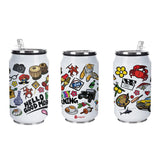Innovative Ganesh Chaturthi Ganpati Idols
Ganesh Chaturthi is one of the important festivals celebrated in India with great enthusiasm and devotion. The festival symbols the birthday of Lord Ganesha; the Lord of knowledge, wisdom, prosperity and good fortune. The festival is also famously known as Vinayak Chaturthi or Vinayak Chavithi. This day is observed as one of the most auspicious in the Hindu religion.
Every year, Ganesh Chaturthi celebrations culminate in the immersion of Ganesha idols into the sea, rivers, lakes or ponds. As most idols are made from Plaster of Paris and toxic, non-biodegradable chemical colours, the immersion ends up causing considerable harm to marine life. In an attempt to reduce the environmental damage, many devotees have begun installing Ganpati idols that are both innovative and eco-friendly. In recent years there has been a dramatic jump in the demand for 'green' idols to celebrate the festival this year.
Here are some of the most creative Ganpati's -
Seed Ganesha

Mumbai artist Dattadri Kothur creates eco-friendly Ganpati idols that are made from red soil and fertilisers, and contain plant seeds. At the end of the 10-day festival, the idols undergo a symbolic immersion. Instead of being immersed in a water body, the idol is placed in an accompanying pot and watered until it dissolves. Thanks to the lady finger or tulsi seeds are sown in the pot, the idol grows back as a plant.
Sand Ganesha

Padma Award winning sand artist Sudarsan Pattnaik created a 20 feet long sand sculpture at Odisha’s Puri beach. The green and yellow sand art of Lord Ganesha was accompanied with the message – ‘Go green, beat plastic pollution’.Ganapati idols which are usually made of Plaster of Paris (POP), plastic, cement and coated with toxic paints take several years to fully dissolve in water. Also, it reduces oxygen levels in the water, killing fishes and other aquatic animals.
Ganesha from 500 kg spare parts of cars

The six-feet-tall masterpiece is made from recycled Ford spare parts. The Ganpati idol has been made from over 500 kg of car parts like disk brakes, fenders, clutch plates, flat gears, shaft gears, spark plugs, connecting rods, automobile chains, and crankshafts among other parts.
The creative forces behind the project took nearly 60-70 days to complete the idol and the most difficult and challenging part was the process of hammering and bending the parts to give the desired shape of the body.
Ganesha From Waste
Dr. Binish Desai, a social entrepreneur, waste warrior, and an innovator from Gujarat has come up with one of a kind Eco Ganesha made from jewelry waste.
During the making of artificial jewelry, glass beads are scuffed, leaving powdered waste which is non-recyclable in nature. The jewelry waste is collected, a special binder is used to bind the waste and give it a shape of an idol. Later, the idol is painted using three colors – red, yellow and light purple or crystal. All three colors are derived from flowers, they are environment-friendly. The entire idol is made out of waste.
Fish-friendly Ganesha:

Mumbai-based NGO Sprouts Environmental Trust is making idols that fish can eat. The brainchild of ecologist Anand Pendharkar of the Sprouts Environmental Trust, the statues are made with clay and stuffed with fish-friendly food such as corn, spinach, wheat, and vegetable powder. The team has also reduced the size of the idols and decorated them with biodegradable, organic colors such as turmeric, chandan and gerua.
Chocolate Ganesha

Commercial designer turned baker Rintu Rathod has been adding a sweet touch to the festival with her chocolate Ganeshas. She began making chocolate Ganeshas which, upon immersion in milk, became the perfect recipe for milkshakes, much to the delight of children in different orphanages where the milkshake is then distributed.
Ganesha from Spices

Keeping with the legacy of making creative eco-friendly idols for the past five years, members of Shree Sai Darshan Mitra Nandal, Malad (West), have made an idol using pulp from discarded newspapers and rice starch. The idol has been decorated with Indian spices such as clove, cinnamon, chilly, cardamom and mustard seeds.
Weighing approximately 190 kgs, the idol consists of nine kg clove, 20 kg cinnamon, six kg cardamom, two kg chilly and a kg of mustard seeds.
Coconut Shells Ganesha

Venkatraman Bhat has been creating intricate works of art such as Ganesha, Krishna, Jesus Christ, Shakuntala, and Geethopadesha using coconut shells for 45 years now. He begins with a thought and then works with each shell smoothening it. The shells are glued as per the design and come together as a work of art.
He started experimenting with various methods to make art pieces from coconut shells.
Alum Ganesha

Pune-based artist Vivek Kamble has been making alum Ganesha idols that can quickly dissolve in water. As alum is often used for the purification of waste water, the statues also help in cleaning the water. The idols are designed with food colors, and weigh between 1 to 1.5 kg and are up to 10 inches tall.
Cow Dung Ganesha

Navnath Dudhal, he has found a novel way to make Ganeshotsav eco-friendly using dung produced by desi cows. This year, Dr. Dudhal has started making Ganapati idols out of cow dung and is selling them at his Ayurvedic shop. A strong believer in Panchagavya — benefits of cow dung, cow urine, milk, curd, and ghee — Dr. Dudhal has been researching ways to use these products in day-to-day life.
The joy and happiness during the celebration of a festival become fourfold when it is celebrated with the environment. Switch to the eco-friendly festival celebration and help Mother Earth.














1 comment
Very good product
Leave a comment
Please note, comments need to be approved before they are published.